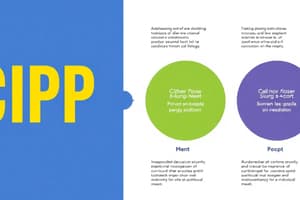Podcast
Questions and Answers
What is a primary focus of Eisner's Connoisseurship Model in evaluating a curriculum?
What is a primary focus of Eisner's Connoisseurship Model in evaluating a curriculum?
- Implementing curriculum changes based on surveys
- Measuring standardized test scores
- Gathering quantitative data from students
- Using the judgment of knowledgeable experts (correct)
In educational criticism, what do evaluators primarily analyze to assess a curriculum's effectiveness?
In educational criticism, what do evaluators primarily analyze to assess a curriculum's effectiveness?
- Technological tools used in the teaching process
- Financial resources allocated to the program
- The physical infrastructure of the classrooms
- The impact on students, teachers, and administrators (correct)
Which of the following tasks exemplifies the application of Eisner's evaluation methods?
Which of the following tasks exemplifies the application of Eisner's evaluation methods?
- Assessing student projects through expert observation (correct)
- Determining student grades based solely on tests
- Surveys to measure student satisfaction levels
- Comparing curriculum standards across different schools
What aspect of teaching does Eisner's model consider crucial for evaluation?
What aspect of teaching does Eisner's model consider crucial for evaluation?
Which evaluation strategy is NOT part of Eisner’s Connoisseurship Model?
Which evaluation strategy is NOT part of Eisner’s Connoisseurship Model?
What is the primary purpose of process evaluation in curriculum implementation?
What is the primary purpose of process evaluation in curriculum implementation?
What do formative evaluations primarily focus on in the context of curriculum?
What do formative evaluations primarily focus on in the context of curriculum?
Which component of the CIPP model focuses on assessing the effectiveness of the curriculum's outcomes?
Which component of the CIPP model focuses on assessing the effectiveness of the curriculum's outcomes?
In what stage of the curriculum process is product evaluation primarily conducted?
In what stage of the curriculum process is product evaluation primarily conducted?
Which of the following best describes the role of process evaluation in curriculum development?
Which of the following best describes the role of process evaluation in curriculum development?
What is the purpose of evaluating a science curriculum?
What is the purpose of evaluating a science curriculum?
Who developed the framework for evaluating curriculum in 1991?
Who developed the framework for evaluating curriculum in 1991?
Which of the following is NOT a key characteristic of evaluating a curriculum?
Which of the following is NOT a key characteristic of evaluating a curriculum?
What method is used to gather insights on the curriculum's effectiveness?
What method is used to gather insights on the curriculum's effectiveness?
In curriculum evaluation, why is assessing learning outcomes important?
In curriculum evaluation, why is assessing learning outcomes important?
What aspect does evaluating a curriculum primarily focus on?
What aspect does evaluating a curriculum primarily focus on?
What is one method used to evaluate curriculum effectiveness?
What is one method used to evaluate curriculum effectiveness?
What does NOT contribute to the evaluation of a curriculum?
What does NOT contribute to the evaluation of a curriculum?
What is the primary purpose of using questionnaires and checklists in data collection?
What is the primary purpose of using questionnaires and checklists in data collection?
What is a significant challenge associated with the use of questionnaires?
What is a significant challenge associated with the use of questionnaires?
Which option best describes the purpose of curriculum evaluation?
Which option best describes the purpose of curriculum evaluation?
What is one advantage of conducting interviews in data collection?
What is one advantage of conducting interviews in data collection?
Why might questionnaires lead to less accurate responses?
Why might questionnaires lead to less accurate responses?
Which statement about the observation of curriculum in action is true?
Which statement about the observation of curriculum in action is true?
What is a disadvantage of using interviews compared to questionnaires?
What is a disadvantage of using interviews compared to questionnaires?
What is NOT an advantage of using questionnaires?
What is NOT an advantage of using questionnaires?
What is the primary goal of teachers when evaluating their instructional practices?
What is the primary goal of teachers when evaluating their instructional practices?
What is considered a challenge in evaluating curriculum according to the content?
What is considered a challenge in evaluating curriculum according to the content?
What area does Context Evaluation focus on when assessing a curriculum?
What area does Context Evaluation focus on when assessing a curriculum?
What is one key purpose of evaluating a curriculum?
What is one key purpose of evaluating a curriculum?
Who developed the model for curriculum evaluation discussed in the content?
Who developed the model for curriculum evaluation discussed in the content?
What does Input Evaluation primarily focus on?
What does Input Evaluation primarily focus on?
How can a curriculum evaluation adapt to changing conditions?
How can a curriculum evaluation adapt to changing conditions?
How does evaluation help in terms of resource allocation?
How does evaluation help in terms of resource allocation?
What is a challenge associated with evaluating a curriculum?
What is a challenge associated with evaluating a curriculum?
What outcome do curriculum developers aim for through analysis of evaluation data?
What outcome do curriculum developers aim for through analysis of evaluation data?
What type of information do stakeholders typically seek regarding curriculum effectiveness?
What type of information do stakeholders typically seek regarding curriculum effectiveness?
What is a potential issue with the data used for evaluating curriculum?
What is a potential issue with the data used for evaluating curriculum?
What advantage does using pre-existing data in evaluations offer?
What advantage does using pre-existing data in evaluations offer?
What potential influence does participant awareness have in evaluations?
What potential influence does participant awareness have in evaluations?
Why is improvement a key purpose of curriculum evaluation?
Why is improvement a key purpose of curriculum evaluation?
What role do documentation reviews play in curriculum evaluation?
What role do documentation reviews play in curriculum evaluation?
Flashcards
Curriculum Evaluation
Curriculum Evaluation
A process of assessing whether a curriculum has reached its goals and objectives.
Documentation Review
Documentation Review
Analyzing existing data on student performance, program activities, and feedback to understand curriculum effectiveness.
Observation
Observation
Gathering information through direct observation of program activities and participants' behavior.
Formative Evaluation
Formative Evaluation
Signup and view all the flashcards
Summative Evaluation
Summative Evaluation
Signup and view all the flashcards
Improvement
Improvement
Signup and view all the flashcards
Decision Making
Decision Making
Signup and view all the flashcards
Influence on Participant Behavior
Influence on Participant Behavior
Signup and view all the flashcards
Questionnaires and Checklists
Questionnaires and Checklists
Signup and view all the flashcards
Interviews
Interviews
Signup and view all the flashcards
Accountability
Accountability
Signup and view all the flashcards
Inexpensive and easy to compare results
Inexpensive and easy to compare results
Signup and view all the flashcards
Responses may not be detailed or accurate
Responses may not be detailed or accurate
Signup and view all the flashcards
Time-consuming and expensive to conduct
Time-consuming and expensive to conduct
Signup and view all the flashcards
Process Evaluation
Process Evaluation
Signup and view all the flashcards
CIPP Model
CIPP Model
Signup and view all the flashcards
Product Evaluation
Product Evaluation
Signup and view all the flashcards
Product Evaluation (purpose)
Product Evaluation (purpose)
Signup and view all the flashcards
Context Evaluation
Context Evaluation
Signup and view all the flashcards
Input Evaluation
Input Evaluation
Signup and view all the flashcards
Outcome Evaluation
Outcome Evaluation
Signup and view all the flashcards
Teacher Feedback
Teacher Feedback
Signup and view all the flashcards
Curriculum Refinement
Curriculum Refinement
Signup and view all the flashcards
Resource Allocation
Resource Allocation
Signup and view all the flashcards
Who Developed Curriculum Evaluation?
Who Developed Curriculum Evaluation?
Signup and view all the flashcards
Curriculum Improvement
Curriculum Improvement
Signup and view all the flashcards
Connoisseurship Model
Connoisseurship Model
Signup and view all the flashcards
Educational Criticism
Educational Criticism
Signup and view all the flashcards
Evaluating a language curriculum
Evaluating a language curriculum
Signup and view all the flashcards
Assessing a math curriculum's impact
Assessing a math curriculum's impact
Signup and view all the flashcards
Evaluating an arts curriculum
Evaluating an arts curriculum
Signup and view all the flashcards
Study Notes
Curriculum Evaluation
- Definition: Systematic data collection to assess a curriculum's value, determining adoption, rejection, or revision.
- Key Purposes: Understanding effectiveness, stakeholder interest, teacher feedback, developer improvement, resource allocation, accountability, decision making, and improvement.
Curriculum Evaluation Models
- CIPP Model (Context, Input, Process, Product): Evaluates curriculum from initial needs to final outcomes.
- Context Evaluation: Identifies needs addressed by the curriculum.
- Input Evaluation: Focuses on resources and implementation plans.
- Process Evaluation: Provides feedback on the implementation in real-time.
- Product Evaluation: Measures achievement of objectives.
- Stake's Countenance Model: Focuses on the conditions before, during, and after instruction.
- Antecedent Phase: Examines conditions before instruction.
- Transaction Phase: Focuses on instructional interactions.
- Outcome Phase: Evaluates the curriculum's results.
- Eisner's Connoisseurship Model: Expert judgment of classroom events.
- Connoisseurship: Evaluation through expert observation and interpretation.
- Educational Criticism: Expert analysis of curriculum impact on students and staff.
Instruments of Data Collection
- Questionnaires and Checklists: Easy administration, anonymity, cost-effective comparisons. Limited detail and possibility of biased wording.
- Interviews: Detailed information gathering, flexible topic adaptation. Time-consuming, difficult data analysis & comparison.
- Observations: Direct classroom interaction insights. Interpretation challenges, potential observer effect.
- Documentation Reviews: Comprehensive historical information. Can lack relevance or be incomplete, time-consuming analysis.
Types of Curriculum Evaluation
- Formative Evaluation: Ongoing during curriculum development and implementation. Provides feedback for improvement.
- Summative Evaluation: Conducted at the end. Assesses effectiveness, determining accomplishment of objectives.
- Key characteristics: Focus on identifying strengths and weaknesses, expert reviews, pilot tests, and feedback from teachers and learners.
- Example: Assessing a new math curriculum's contribution to problem-solving skills after a year.
Studying That Suits You
Use AI to generate personalized quizzes and flashcards to suit your learning preferences.




